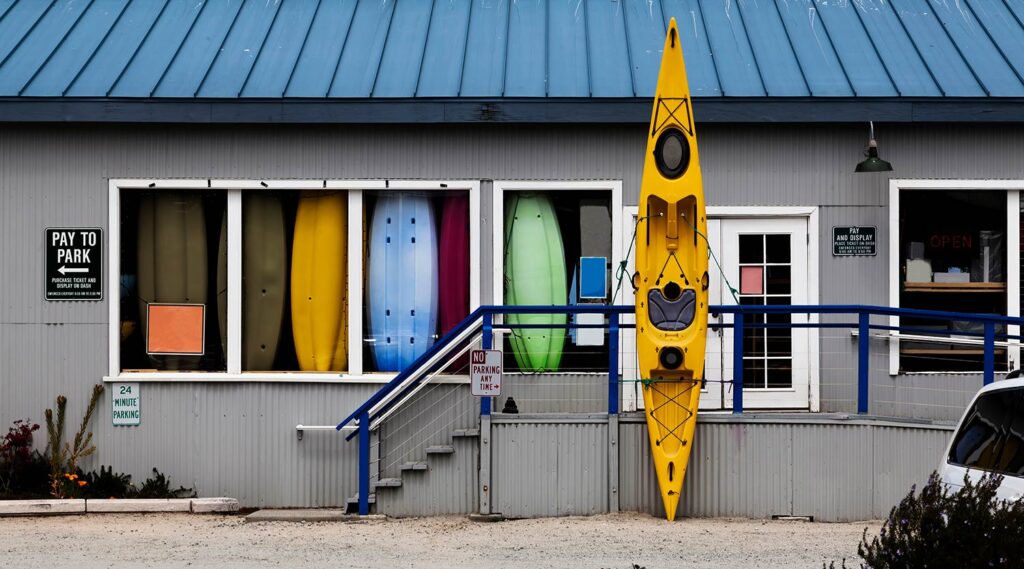Picking the best kayak anchor cleat ain’t just a quick grab from the shelf. Some slip, others rust fast, and a few don’t even hold tight when current kicks in. If your anchor line keeps loosening or snags during fishing, that’s a problem. You need something that fits your setup, holds firm, and don’t rattle every time you move. These 5 top-rated anchor cleats for kayaks actually get the job done without messing up your trip.
Best 5 Kayak Anchor Cleats
01. MIZUGIWA Kayak Anchor Cleat
The MIZUGIWA Kayak Anchor Cleat is a compact and track-compatible solution for paddlers who want quick and secure anchor line control. It fits most kayak track rail systems like YakAttack, RAILBLAZA, and Scotty, allowing you to install it without drilling holes into your kayak. Whether you’re anchoring in current while fishing or holding position in wind, this cleat makes it easy to adjust your line without tangles or knot work.
Made from a combination of marine-grade nylon and stainless steel hardware, the cleat is built to handle freshwater and saltwater trips. It’s a lightweight piece but does the job for small to medium anchors or anchor trolleys. Keep in mind, it’s not made for heavy-duty anchors, and the nylon base can wear if overtightened or exposed to too much UV over time.
✅ Pros
- Compatible with most kayak track systems
- Tool-free installation – no drilling required
- Great for anchoring while kayak fishing or paddling in current
- Corrosion-resistant hardware
❌ Cons
- Nylon body isn’t suited for large or heavy anchors
- UV exposure may degrade the material over time
- May need retightening after long trips or vibration
02. 1007 Kayak Anchor Cleat
The 1007 Kayak Anchor Cleat by EDSRDPLT (Aventik) is a track-mountable solution designed for paddlers who want simple, fast anchor control without extra hardware or drilling. It’s compatible with most kayak gear tracks like YakAttack, RAILBLAZA, and other T-slot systems. This cleat allows you to tie off or adjust anchor lines, drift socks, or even tow ropes easily while keeping your deck clutter-free.
It comes with stainless steel bolts and a reinforced plastic cleat body, which holds well under light to medium loads. Perfect for kayak anglers or solo paddlers who want a no-fuss way to manage anchor lines. That said, it’s not ideal for rough saltwater conditions or heavy-duty setups where constant pressure is applied to the cleat.
✅ Pros
- Compatible with most standard kayak track systems
- Easy to install — no drilling needed
- Useful for anchoring, drag chains, or drift socks
- Compact design won’t take up too much track space
❌ Cons
- Plastic body may not hold up under heavy strain
- Not built for larger anchors or harsh ocean use
- May need periodic tightening after extended use
03. Atader Line Cleat for Kayak Track Mount
The Atader Line Cleat for Kayak Track Mount offers a compact and reliable way to manage anchor lines, trolley ropes, or tow cords on your kayak. It’s designed to slide easily into most standard gear track systems like YakAttack, RAILBLAZA, and Scotty. This cleat makes it simple to tie off or adjust lines on the fly – a must-have for kayak fishing, anchoring in wind, or holding position in current without drilling holes or adding extra hardware.
The body is made from tough plastic with stainless steel hardware included, making it a solid pick for both freshwater and light saltwater trips. It’s a tool-free install, and the low-profile design keeps your deck clean. Just be aware that the cleat’s grip isn’t the best for very thick rope, and the plastic can flex if too much force is applied.
✅ Pros
- Fits most kayak gear track systems (YakAttack, RAILBLAZA, etc.)
- Great for anchor line and trolley control
- Lightweight and installs without tools
- Stainless steel hardware resists rust
❌ Cons
- Not ideal for thicker ropes or heavy-duty lines
- Plastic body may flex under strong load
- May loosen slightly with repeated use over time
04. VTurboWay 2 Pcs Line Cleat for Kayak Track Mount
The VTurboWay 2 Pcs Line Cleat for Kayak Track Mount is a practical pick for paddlers looking to manage anchor lines, drift socks, or tow ropes on a track-equipped kayak. Designed to fit most T-track systems like YakAttack GearTrac, RAILBLAZA, and Scotty, these cleats let you secure or adjust rope without drilling holes or reaching for extra tools. With a smooth threading base and vertical cleat slots, they’re a handy option for kayak anglers who need on-the-fly adjustments.
Each pack comes with 2 cleats and stainless steel hardware, offering decent corrosion resistance for freshwater and casual saltwater use. The cleats themselves are made of rigid nylon – strong enough for moderate loads, but not meant for super heavy anchor lines or open-ocean conditions. They do the job well for casual or weekend paddlers.
✅ Pros
- Compatible with most kayak track systems
- 2-pack offers good value for basic anchor line control
- Lightweight and installs without tools
- Stainless steel hardware helps prevent rust
❌ Cons
- Not ideal for large anchors or thick rope
- Nylon base can wear out if overtightened
- May loosen slightly under constant tension
05. YakAttack GT Cleat Track Mount Line Cleat
The YakAttack GT Cleat Track Mount Line Cleat is a smart, low-profile solution for securing anchor lines, trolley ropes, and drift sock cords on kayaks outfitted with track systems. It’s designed specifically for YakAttack GearTrac and MightyMount, but also works well with many other T-slot kayak tracks. Unlike bulkier cleats, this one sits close to the deck, reducing snags while paddling or casting – a big plus for kayak anglers.
Built from marine-grade materials, the GT Cleat holds up well in both freshwater and saltwater environments. It’s lightweight but impressively solid, and installation is tool-free – just slide it in, hand-tighten, and it’s ready. While it’s great for smaller anchors and line control, the compact size might not be ideal if you’re running thicker rope or heavy loads.
✅ Pros
- Fits YakAttack GearTrac, MightyMount, and most T-track systems
- Ultra low-profile – reduces snags on deck
- Durable, weather-resistant construction
- Tool-free, quick installation
❌ Cons
- Not ideal for thick or heavy-duty ropes
- A bit pricier than generic cleats
- Limited to track-equipped kayaks only
How to Choose the Best Kayak Anchor Cleats
Finding the right kayak anchor cleat ain’t something you leave to guessing. Lotta folks think any ol’ piece of plastic will do, but that’s how your anchor line ends up slipping when you’re tryna fish. If you’re paddling out to still water or trying to hold your spot in a light current, the right cleat makes all the difference. But choosing wrong can ruin your day real quick.
Think About the Type of Water You Paddle In
Not all anchor cleats for kayaks work the same. Are you in a calm lake or a spot with fast river current? That changes what you need. For slow-moving lakes or ponds, basic zig-zag cleats or jam cleats do just fine. They cheap, and they hold small-diameter ropes tight enough.
Now, for coastal areas or faster-flowing rivers, you better go with metal anchor cleats or locking cleats. Wind and current can yank that rope hard – plastic ain’t gonna hold up long in those conditions. It might snap or strip out the mounting holes. Then you got no anchor and no cleat. Not fun.
Material Ain’t Just About Looks
Some folks think plastic’s good enough. But cheap ABS plastic cleats can weaken with sun exposure. UV rays eat ’em alive over time. If you paddle a lot, especially in sunny places like Florida or Texas, get UV-resistant nylon cleats or better – marine-grade stainless steel anchor cleats.
Stainless steel cleats don’t rust, even if you hit saltwater. Yes, they heavier and cost more, but they last years longer. You won’t have to swap it out every season.
Mounting Style and Location Matter a Lot
You can’t just slap it anywhere on the kayak. First thing you need to look at is where your anchor trolley system runs – if you got one. Cleat should sit where you can reach it easy, but also where it won’t mess up paddling. Most folks mount it near the seat or at side rails.
There’s bolt-on anchor cleats that need drilled holes, and adhesive-backed cleats too. Adhesive ones ain’t strong enough for fast current or heavy loads. Don’t trust ’em if you anchor in deeper waters. Go bolt-on and seal the screws with marine-grade silicone. That keeps water out and holds tight.
Size and Rope Compatibility
Rope size matters. A cleat meant for 3/16″ rope won’t hold 3/8″ line. It’ll jam or slip. Check what size line you use for your anchor. Most kayak anchor lines fall in 3/16″ to 1/4″ range. Make sure the cleat is rated for it.
A good kayak anchor cleat should grab fast but release smooth too. You don’t wanna be fighting it when the wind shifts and you gotta move.
Cleat Types You Might Run Into
Here’s the common ones:
- Zig Zag Cleat: Super popular. Holds tight, no knots needed. Just wrap the rope through the grooves and it locks. Great for beginners and light-duty setups.
- Jam Cleat: Rope slides one way but locks the other. Fast to use, but can fray rope over time.
- Flip-Up Cleat: More like traditional boat cleats. Lays flat, flips up when needed. Good for a clean deck.
- Clam Cleat: Looks small but works well with thin ropes. Better for light-duty anchoring or attaching other gear.
Each one’s got pros and cons. If you’re fishing in current? Zig-zag cleat’s easy to use. Want something flush and sleek? Flip-up’s better.
Fishing or Not? That Changes Everything
You fish a lot? Then your cleat needs to lock solid and not rattle. Fish hear that stuff. Also, some cleats snag your line when casting if they stick out too much. Go for a low-profile anchor cleat if you’re in tight spaces.
Also, when you’re reeling in or moving spots, you want a cleat you can handle one-handed. Some models let you adjust rope tension while keeping the rod in your other hand. Saves time. And your patience.
Weather and Saltwater Corrosion Issues
If you’re anywhere near the ocean, don’t even think about using non-stainless steel. Salt eats metal fast. A zinc-coated cleat might last a season or two at best. Then rust hits. So either go anodized aluminum, 316 stainless steel, or some marine-grade composite that’s made for saltwater use.
Look at the screws too – some folks mount stainless cleats using regular steel bolts. That defeats the purpose. Always match your cleat and mounting hardware for corrosion resistance.
Cost vs. Reliability
You can get kayak cleats for 5 bucks or spend $30+. But cheap ones usually lack strength or don’t stay tight. And when your anchor slips ’cause the cleat gave out? You’ll wish you paid the extra ten.
Also, don’t buy packs with multiple sizes unless you’re outfitting more than one kayak. Just get the size and shape you need. Most solo paddlers only need one or two good cleats placed right.






